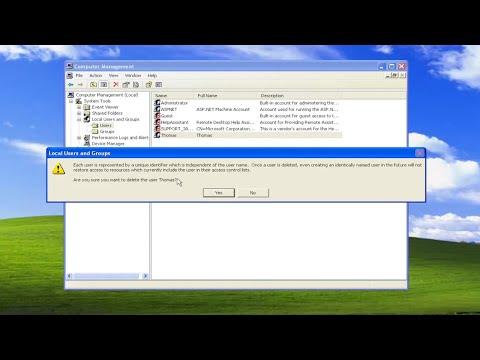I was having a pretty standard day at the office when I stumbled upon an unexpected problem. My computer was running on Windows XP, a system I hadn’t worked with in years. I was tasked with removing a user account from the machine, and although it seemed straightforward, I quickly realized that the process wasn’t as intuitive as I remembered. The account in question belonged to a former employee, and removing it was crucial for maintaining the security and organization of our system.
Initially, I approached this task with a sense of familiarity. After all, Windows XP had been my go-to operating system for a long time. However, as soon as I started navigating the Control Panel and User Accounts section, it became clear that things weren’t as simple as they used to be. The interface was less intuitive than the more recent versions of Windows, and I had to remind myself of the specifics of the XP environment.
First, I opened the Start menu, which was still the familiar old classic design. I clicked on “Control Panel” and then selected “User Accounts.” I saw a list of user accounts set up on the computer, which included the one I needed to remove. I chose the account to delete, hoping that the process would be as straightforward as just clicking “Delete” and confirming. However, I was met with a series of prompts that made me rethink my approach.
I was presented with a few options: “Change an account,” “Create a new account,” and, of course, the option to “Delete the account.” I selected “Delete the account” but was immediately hit with a decision about whether to keep or delete the user’s files. Since the files were no longer necessary for our operations, I chose to delete them as well. However, there was no clear confirmation step, and I had to ensure I wasn’t accidentally deleting important system files or other critical information.
The system then warned me about the potential impact of deleting the account, suggesting that this action was irreversible. I had to double-check that I had backed up any important data and that the account I was about to remove was indeed the correct one. It was a good practice to verify the account details before proceeding, especially given the sensitive nature of the task.
After making sure everything was in order, I clicked “Delete Account” one more time. The process seemed to take a few moments, during which I held my breath, hoping that nothing would go wrong. Finally, the account was removed, and I was relieved to see that the User Accounts section no longer displayed the former employee’s name.
To ensure that everything had been done correctly, I rebooted the system and checked the User Accounts list again. The account was indeed gone, and everything appeared to be functioning as it should. I also verified that the files associated with that account were deleted and that no residual data was left behind.
The whole process made me appreciate how far operating systems had come since Windows XP. While XP was a reliable and revolutionary system in its time, its interface and processes could feel outdated and cumbersome compared to more modern versions of Windows. Nevertheless, the principles of user account management remained the same, and I was able to navigate the task with a bit of patience and attention to detail.
Reflecting on this experience, I realized that working with older technology often requires a different mindset. While newer systems might offer more streamlined and user-friendly interfaces, older systems like Windows XP have their own quirks and challenges. It’s essential to approach these tasks with caution and thoroughness to avoid any unintended consequences.
In summary, removing a user account in Windows XP requires careful navigation through the Control Panel and User Accounts section. It’s important to back up any necessary data and double-check the account details before deletion. The process may feel somewhat outdated compared to more recent operating systems, but with a bit of patience, it’s entirely manageable. This experience served as a reminder that regardless of the technology, the principles of careful and methodical work remain crucial for successful outcomes.
